
The Maratha Empire or the Maratha Confederacy was a power that dominated a large portion of the Indian subcontinent in the 18th century. The empire formally existed from 1674 with the coronation of Shivaji as the Chhatrapati and ended in 1818 with the defeat of Peshwa Bajirao II at the hands of the British East India Company. The Marathas are credited to a large extent for ending Mughal Rule over most of the Indian subcontinent.
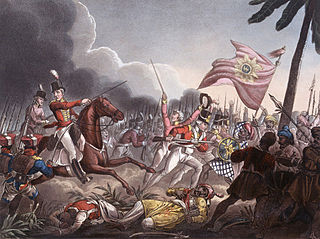
The Second Anglo-Maratha War (1803–1805) was the second conflict between the British East India Company and the Maratha Empire in India.
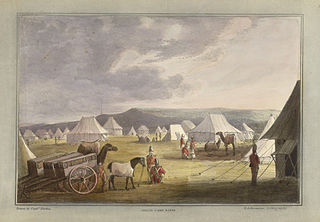
The Third Anglo-Maratha War (1817–1818) was the final and decisive conflict between the British East India Company (EIC) and the Maratha Empire in India. The war left the Company in control of most of India. It began with an invasion of Maratha territory by British East India Company troops, and although the British were outnumbered, the Maratha army was decimated. The troops were led by Governor General Hastings, supported by a force under General Thomas Hislop. Operations began against the Pindaris, a band of Muslim mercenaries and Marathas from central India.

Nana Saheb Peshwa II, born as Dhondu Pant, was an Indian Peshwa of the Maratha empire, aristocrat and fighter, who led the rebellion in Kanpur (Kanpur) during the Indian Rebellion of 1857. As the adopted son of the exiled Maratha Peshwa Baji Rao II, Nana Saheb believed that he was entitled to a pension from the East India Company, but the underlying contractual issues are rather murky. The Company's refusal to continue the pension after his father's death, as well as what he perceived as high-handed policies, compelled him to revolt and seek independence from company rule in India. He forced the British garrison in Kanpur to surrender, then executed the survivors, gaining control of Kanpur for a few days. He later disappeared, after his forces were defeated by a British force that recaptured Kanpur. He went to the Nepal Hills in 1859, where he is thought to have died.
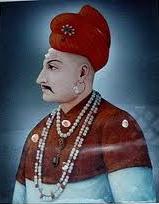
Shrimant Peshwa Balaji Bajirao Bhat, also known as Nana Saheb, was the 8th Peshwa of the Maratha Empire in India. He was appointed as Peshwa in 1740 upon the death of his illustrious father, the Peshwa Bajirao I.

Shahu Bhosale I was the fifth Chhatrapati of the Maratha Empire created by his grandfather, Shivaji. Born in the Bhonsle family, he was the son of Sambhaji, Shivaji's eldest son and successor. Shahu, as a child, was taken prisoner along with his mother in 1689 by Mughal sardar, Zulfikar Khan Nusrat Jang. After the death of Aurangzeb in 1707, leading Mughal courtiers released Shahu with a force of fifty men, thinking that a friendly Maratha leader would be a useful ally. At that time he fought a brief war with his aunt Tarabai in an internecine conflict to gain the Maratha throne in 1708.
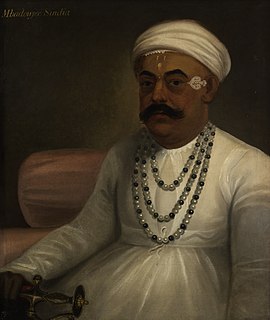
Mahadaji Shinde also spelled as Mahadji Scindia was a Maratha Statesman and ruler of Ujjain in Central India. He was the fifth and the youngest son of Ranoji Rao Scindia, the founder of the Scindia dynasty.

Shrimant Daulat Rao Sindhia (Shinde) was the king (Maharaja) of Gwalior state in central India from 1794 until his death in 1827. His reign coincided with struggles for supremacy within the Maratha Confederacy, and wars with the expanding East India Company. Daulatrao played a significant role in the Second and Third Anglo-Maratha wars.

The Battle of Khadki, also known as or The Battle of Ganeshkhind, took place at modern day Khadki, India on 5 November 1817 between the forces of the British East India Company and the Maratha Empire under the leadership of Appasaheb Bhonsle. The Company forces achieved a decisive victory, and Khadki later became a military cantonment under the British rule.

The Kingdom of Nagpur was a kingdom in east-central India founded by the Gond rulers of Deogarh in the early 18th century. It came under the rule of the Marathas of the Bhonsle dynasty in the mid-18th century and became part of the Maratha Empire. The city of Nagpur was the capital of the state.
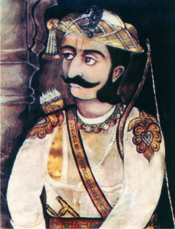
Raghoji I Bhonsale of the Bhonsale dynasty, was a Maratha general who took control of the Nagpur Kingdom in east-central India during the reign of Chattrapati Shahu. His successors ruled the kingdom until 1853.

H. H. Maharajadhiraj Raj Rajeshwar ShrimantChakravarti Chhatrapati Yashwant Rao Holkar Bahadur (1776-1811), belonging to the Holkar dynasty of the Maratha Empire was the Maharaja of the Maratha Empire. He was a gifted military leader and educated in accountancy as well as literate in Persian and Marathi.

Raghuji Bhonsale II or Raghuji II Bhonsale was the Maratha ruler of the Kingdom of Nagpur in Central India from 1788 to 1816.

The Foundation year of NAGPUR is the year of 1702 . The history of Nagpur, in central India, spans over 5,000 years, including the Kingdom of Nagpur in the 18th and 19th century. Human existence around present-day Nagpur city can be traced back 3,000 years to the 8th century BC. Menhir burial sites at Drugdhamna indicate megalithic culture existed around Nagpur and is still followed in present times.

Sitabuldi Fort, site of the Battle of Sitabuldi in 1817, is located atop a hillock in central Nagpur, Maharashtra, India. this fort was built by a Gond king, Raja Bhakth Buland Shahin year 1702, then with some political reason or negotiation between bhosels and rajgonds this capital of gonwan kwon, so it is wrong to say that Sitabuldi Fort was built by bholes rather it was built by rajgond king. then just before he fought against the British East India Company during the Third Anglo-Maratha War. The area surrounding the hillock, now known as Sitabuldi, is an important commercial hub for Nagpur. To the south is Nagpur Railway Station and behind it is Tekdi Ganapati, a temple of Ganesha. The fort is now home to the Indian Army's 118th infantry battalion.

The siege of Trichinopoly was part of an extended series of conflicts between the Nizam of Hyderabad and the Maratha Empire for control of the Carnatic region. On 29 August 1743, after a six-month siege, Murari Rao surrendered, giving Nizam ul Mulk (Nizam) the suzerainty of Trichinopoly. By the end of 1743, the Nizam had regained full control of Deccan. This stopped the Maratha interference in the region and ended their hegemony over the Carnatic. The Nizam resolved the internal conflicts among the regional hereditary nobles (Nawabs) for the seat of governor (Subedar) of Arcot State, and monitored the activities of the British East India company and French East India Company by limiting their access to ports and trading.
Khan Bahadur Bakshi Ghulam Haider Khan was Faujdar of a unit at the time of Battle of Assaye, which was a major battle of the Second Anglo-Maratha War under the command of Major General Arthur Wellesley. Latterly, he became the royal chief head of the military services hence called the Mir Bakshi. He was in charge of intelligence gathering, and also made recommendations to the royal court for military appointments and promotions.

The greatest ruler of the Rajgond dynasty was Bakht Buland Shah. He added to his kingdom, the territories of Chanda and Mandla, and portions of Nagpur, Balaghat, Seoni, and Bhandara. He also annexed the adjoining Rajput kingdom of Kherla. The present districts of Chhindwara and Betul also fell under his control. A great warrior, he went on to conquer Pauni, Dongartal, Sivni&Katangi.

Maharaja Man Singh was the last independent Maharaja of Marwar Kingdom and Jodhpur State. He was appointed as Heir Apparent by his grandfather Vijay Singh on 7 November 1791. However upon Vijay Singhs death, Bhim Singh seized Jodhpur and proclaimed himself as the ruler of Marwar.
The Bhat Peshwa family earlier known as Bhat family is a prominent Indian Brahmin family who dominated India for around 100 years in the 18th century. Most of the members in this family were the Peshwas in the Peshwa Era of the Maratha Empire, and Peshwa later became their family name. During their regime, most of the Indian subcontinent was under their control. The last Peshwa, Baji Rao II, was defeated by the British East India Company in the Third Anglo-Maratha War in 1818. The territory was annexed to the British East India Company's Bombay Presidency, and he was pensioned


















